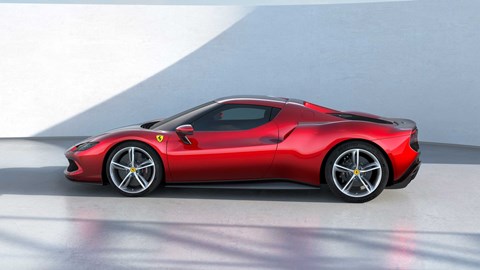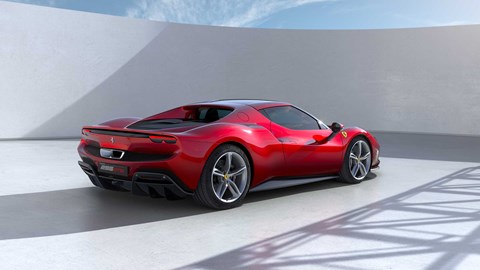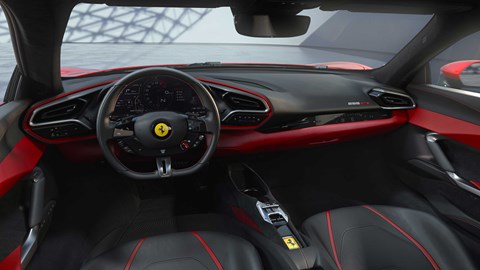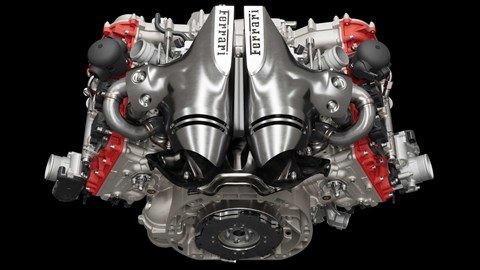► New Ferrari opts for V6 hybrid power
► 818bhp to the rear wheels
► A new era, with old style
You’re looking at the new Ferrari 296 GTB, a V6 hybrid that ushers in a new era for the Prancing Horse. It wears an exterior design that borrows from the most beautiful Ferrari ever built, the 250LM, and adds all the technology you’d expect in 2021 – and a tonne of power.
Ferrari is only too aware of what it calls this car’s ‘epoch-making importance’. Its mid-engined V8s have sat clear at the top, more or less, since the 458 Italia – arguably earlier. Now the GTB must continue that superiority in the hybrid arena. Here’s everything you need to know.
Ferrari 296 GTS: the open-top hybrid supercar

It looks good!
Walk up to it, clock the artful blend of influences new and old and climb in. The cockpit’s smart but predictable – Maranello’s recently introduced HMI and touch-heavy controls in a more aggressively styled, less classical space than the Roma (the car, together with the SF90, in which this generation of tech made its debut). Note that the mannetino offers eDrive, Hybrid, Performance and state-of-charge shredding Qualify.
What’s the power?
The 296 GTB uses a 3.0-litre V6 that’s smaller and lighter than a 4.0-litre V8 (by 30kg), helping offset the weight of its battery and e-motor (which we’ll get to later) and reduce the wheelbase (by 50mm) despite the introduction of the latter into the driveline.
The 120° angle usefully lowers the centre of gravity while giving plenty of space for the turbos within the vee of the engine. At the same time, there are a raft of knock-on advantages for the entire engine ecosystem, block, manifolds, exhausts and turbos. Power is prodigious; 654bhp, or 218bhp per litre. Total power is a lofty 818bhp. The F8 Tributo makes 710bhp; McLaren’s Artura 671bhp.

With the turbos inside the vee, close to the manifolds, plumbing is so short and direct as to be almost non-existent, the better to reduce weight, lag and the throttle pedal’s response time – Ferrari modestly describes the latter as ‘zero’. At the same time the exhaust system (in lightweight, heat-resistance Inconel) is kept compact and relatively simple, running from the hot vee to a single large tailpipe on the new GTB.
The turbos – optimised and miniaturised – spin to 180,000rpm which ultimately means less lag. Timing is by a dedicated chain per cylinder bank, because who’d go to all this trouble only to stick on belts?
That all adds up to 0-124mph in just 7.3 seconds.
Prancing e-horses
Battery capacity clocks in at 7.4kWh for the GTB and a a single compact axial flux e-motor sits in the driveline. There, its efforts are controlled by the car’s ECU and introduced or isolated from the drivetrain by what Ferrari’s calling the Transition Manager Actuator – effectively a clutch, to allow the e-motor to power the car solo of in cahoots with the V6.
The fastest hybrid cars
It’s able to charge the battery, start the V6, supply additional power and torque (165bhp and 232lb ft) and allow for electric-only driving for 15.5 miles at speeds of up to 84mph.
And none of it is sent to the front axle: Push the front wheels and you corrupt the steering, add weight and complexity and shrink the clear water between your two mid-engined hybrids.

But how will it feel?
Beyond ballistic, our guess is that the 296 GTB will feel like the most intuitive, approachable and exploitable 800bhp car you ever drove…
Hybrid F1 power: how does it work?
The 296 gets the lot: a new six-way Chassis Dynamic Sensor able to discern the car’s acceleration in speed in all three axis; an upgraded ABS controller for smarter stops despite the complexity of managing regeneration on the rear axle (Maranello’s claiming an 8.8% reduction in braking distance from 124-0mph versus the F8, and a 24% increase in repeat braking efficiency); Side Slip Control; an e-diff; and a new input feed from the power steering to help the car build a crystal clear of where you and the GTB are relative the limits, and what it should – or shouldn’t – do to help.

Need more?
Then you’ll want the Assetto Fiorano version. More wedge, naturally, but you get Multimatic dampers optimised for track use, additional carbonfibre front bumper elements that boost downforce, and a smattering of lightweight materials that save 15kg in total (the Lexan rear screen shaves off 3kg in one go). And there’s also Cup 2R tyres and the option of an AF-exclusive 250 LM-inspired paint scheme… That trackday at Brands won’t know what hit it.